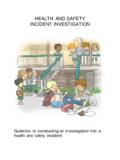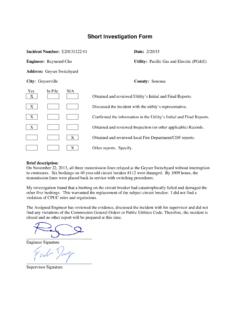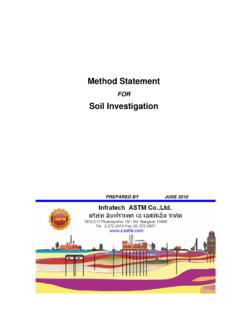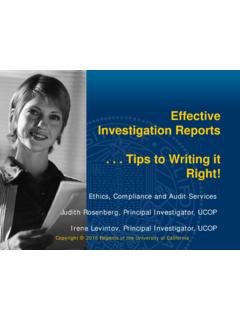Transcription of Arthur G. Dozier School for Boys Abuse Investigation
1 January 29, 2010 Case No. EI-04-0005. Florida Department of Law Enforcement OFFICE OF EXECUTIVE INVESTIGATIONS. Arthur G. Dozier School for boys Abuse Investigation INVESTIGATIVE SUMMARY. INVESTIGATIVE PREDICATE. On December 9, 2008, Governor Charlie Crist directed the Florida Department of Law Enforcement (FDLE) to investigate 32 unmarked graves located on property surrounding the Arthur G. Dozier School for boys in Marianna, Florida. The request was made due to Abuse allegations brought forth by individuals known as The White House boys Survivors Organization. The individuals are former students who attended the reformatory School during the late 1950's through 1960's and who allege that during their tenure they were subjected to repeated physical Abuse by staff members as a form of discipline.
2 The individuals believe there may be fellow students who died from the Abuse and therefore may be buried at the School cemetery. Governor Crist requested that FDLE determine: 1) The entity that owned or operated the property at the time the graves were placed, 2) Identification, where possible, of the remains of those individuals buried on the site and 3) Determine if any crimes were committed, and if so, the perpetrators of those crimes. On May 14, 2009, FDLE concluded parts 1 and 2 of Governor Crist's directive regarding 1) The identification/ownership of the property known as the Boot Hill Cemetery and 2) The identification of those students who died and were buried at the cemetery (FDLE Case Summary EI-73-8455).
3 The purpose of this report is to address allegations of physical Abuse that occurred from 1940. through 1969, and determine 1) The person or persons responsible and 2) If said Abuse rises to a level that would warrant criminal prosecution. HISTORY OF THE School . Mandated by the Florida Legislature in 1897, the Florida State Reform School ( School ) opened its doors January 1, 1900, to provide a place where young offenders against the laws of our state might be separated from older more vicious associates {Florida Children's Commission 1953}. Page 1 of 13. January 29, 2010 CASE NO. EI-04-0005. The management and affairs of the School have been housed under a multitude of entities during the last 109 years.
4 In 1897, the Governor appointed five commissioners whose duty it was to superintend, manage the School , and report to the Legislature biennially. Shortly thereafter, the responsibility of the School was managed by The Board of Commissioners of State Institutions which consisted of the Governor, Secretary of State, Attorney General, Comptroller, Treasurer, Superintendent of Public Instruction, and the Commissioner of Agriculture. In 1969, the Legislature enacted the Government Reorganization Act that resulted in the Division of Youth Services, which became part of the Florida Department of Health and Rehabilitative Services (HRS). In 1990, HRS transferred the School 's management to their Children and Family Services Program Office.
5 In 1994, the responsibilities of the School fell under a new state agency, the Florida Department of Juvenile Justice, which is still managing the School today. The School has remained open throughout the years having been known as the Florida State Reform School (1900-1913), the Florida Industrial School for boys (1914-1957), the Florida School for boys (1957-1967), and currently operates as the Arthur G. Dozier School for boys . Today, the School is considered a high-risk residential commitment facility for boys 13-21 years of age. In the early years, the facility was situated on almost 1,400 acres and periodically housed both male and female students, some as young as six years old. Many of these students were committed to the facility for minor offenses, such as incorrigibility or truancy.
6 White and colored students were segregated from one another until 1968. The School had two campuses, the South Side or Number 1 side for the white students and the North Side or Number 2 . side for colored students. The School 's North Side campus, where the cemetery was located, was permanently closed between 1990 and 1991. (The terms white and colored are used throughout this report as a means of identification based on the terms of reference utilized during the first sixty plus years of the School 's existence. Whites and colored were separated not only physically but also administratively in School ledgers.). Individual Rating System For over 80 years, the School was an open campus facility with no perimeter fencing or structure to discourage students from escaping.
7 While the majority of students abided by School rules, there were those who ran away on a regular basis even after having been previously caught. One incentive to dissuade escapees and unruly behavior was the Individual Rating System. Beginning in 1931, students were rated and awarded points based on attitude, responsibility, achievements, etc. Upon entering the School , a student started as a Rookie and had the potential to advance through the ranks of Explorer (also referred to as Polywog), Pioneer, Pilot, and finally Ace. As a student advanced in rank he received additional privileges, to include going off campus unattended by an adult staff member. Conversely, if demoted, he lost those privileges.
8 A student found guilty of lying, stealing, cursing, cheating, abusing property, or running away was immediately demoted to the special rank of Grub (also referred to as Punk) regardless of any rank he had attained before. Page 2 of 13. January 29, 2010 CASE NO. EI-04-0005. THE WHITE HOUSE boys . The original founding members of the White House boys consisted of Roger Kiser (formerly known as Kaiser), Michael O'McCarthy (formerly known as Babarsky), Richard Dick Colon, and Robert Straley. In the past year, the group's relationship with one another has become strained and they have since divided into separate organizations now known as: The White House boys , The White House boys Survivor Organization Corporation, and The Official White House boys .
9 Both O'McCarthy and Kiser are authors and have published books and autobiographies about their experiences while at the Florida School for boys . While students at the School , whenever they were disciplined, they and others were sent to a small white building located on the South Side campus. The building became known as the White House and the former students who were punished there refer to themselves as the White House boys .. Roger Kiser (Student from June 1959-March 1960) stated that he was sent to the White House on five separate occasions, but was only spanked on two. Kiser believed the other three occasions were an attempt by Mr. Robert Currie (Staff Social Worker) to terrorize him. Kiser stated that the first time he was spanked 40 to 50 times by Mr.
10 Hatton (Staff Member). Kiser stated that he was spanked with such force that his buttocks were black and blue and bloody and that his underwear was imbedded into his skin. Kiser stated that on the second occasion, he received 25 to 30 spankings from Mr. Tidwell (Staff Member). Kiser stated that he has no residual scars as a result of his spankings. Robert Straley (Student from March 1963-January 1964) stated that when he was sent to the White House, he received 40 lashes by Mr. Tidwell which resulted in blood blisters or deep black and purple pinholes all over his buttocks. Straley worked as a hospital boy and recalled boys being treated for wounds they received as a result of their spankings. Straley helped soak their wounds in Epsom salts and hydrogen peroxide.






